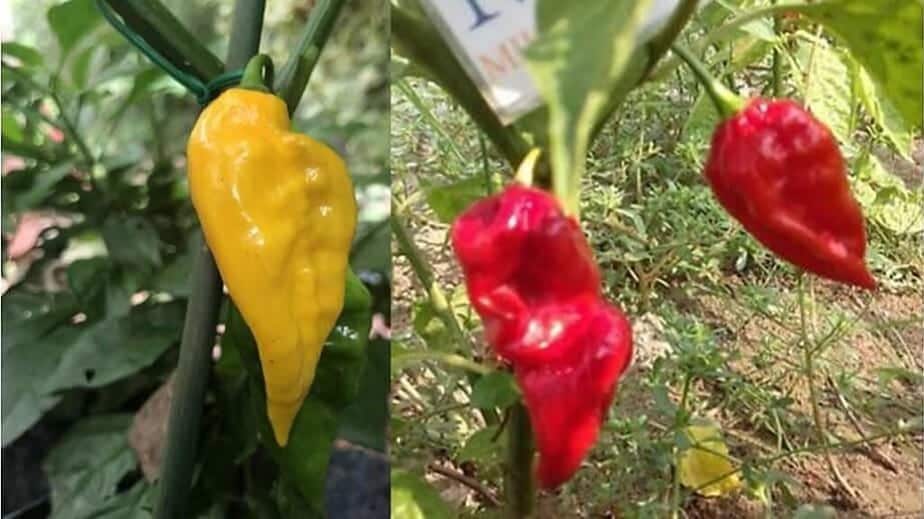The name “Devil’s Tongue” is an indication of what you can expect from the pepper. In your wildest imagination, the shape of the devil’s tongue could be a horrifying image – twisted, folded, pointed, or bloody. This Pennsylvanian pepper has a habanero-like twisted and folded shape and a mega heat that many cannot tolerate. Chili with a mixture of vibrant color, fruity flavor, and super heat that is more than what you needed for making a perfect hot salsa.
What Is Devil’s Tongue Pepper?
The devil’s tongue pepper (DTP) is a mega hot chili with a deliciously sweet, fruity flavor. From its color and shape, many mistakes it to be a Fatalii pepper but it has a smaller size and smoother skin.
The origin of the pepper is said to be in Pennsylvania, created by an Amish farmer but it isn’t verified. Anyways, it was first discovered in Pennsylvania growing among other habanero peppers.
Today, you’ll find mainly three different varieties of this pepper according to the color:
White Devil’s Tongue Pepper: Among the super-hot pepper, the white devil’s tongue pepper is a rare variation that is in high demand. It looks like Fatalii but sweeter and hotter with a light habanero flavor. This pepper has a slight yellow tint when fully matured and ripens from green to purple color and then white.
Red Devil’s Tongue Pepper: The red devil’s tongue pepper is the same as the white except for the color. It’s sweeter and hotter than its cousin Fatalii. They ripen from green to fiery red and literally look like they have been torn straight out of a devil’s mouth.
Yellow Devil’s Tongue Pepper: The yellow devil’s pepper is rarest of the lot and they look identical to Fatalii both in color and shape but hotter and sweeter. They ripen from green to bright yellow.
In addition to these three varieties, there is a chocolate/brown variety as well.
Key Facts In A Gist
- Capsicum species: Chinense
- Origin: Pennsylvania
- Heat level: 125,000 – 325,000 SHU
- Median heat: 225,000 SHU
- Size: average 3 inches long and 1 inch wide
- Shape: tapered, wrinkly, thick-skinned
- Color: red, white, yellow
- Flavor: sweet, fruity, slightly tangy
- Popular Uses: pickling, powder spice
- Main Recipes: hot sauce, salsa
- Substitutes: Habanero, Fatalii, Scotch Bonnet
Devil’s Tongue Pepper Scoville
The heat level of devil’s tongue pepper ranges between 125,000 and 325,000 SHU on the Scoville Scale. They are as hot as the popular habanero peppers. In comparison to Jalapeno which scores around 5,000 SHU on average, the hottest DTP is about 65 times hotter.
The devilish heat of this pepper is not everyone’s cup of tea; while handling this pepper wear gloves and kitchen goggles to prevent chili burns.
What Do They Look and Taste Like?
The Devil’s Tongue pepper plant grows to around 4 feet tall and is a prolific producer. The peppers are about 3 inches long and very thick (above 1 inch in diameter). Depending on the variety, the wrinkly chilies will ripen from green to bright yellow, red, or white. They have an uneven curvy shape and slightly pointed tails, taking on the appearance of a tongue. Its twists, wrinkly folds, and tapered pointed tail-end provide a mean-looking shape, similar to the imaginary tongue of a devil.
Overall, they look much like the Fatalii pepper, another pepper that belongs to the habanero family.
This pepper is hot and sweet but the red devil’s tongue pepper is sweeter and hotter than the yellow, white, and chocolate varieties. Besides their mega heat, a subtle hint of lemon and citrus is present. They are fruity like habanero and Fatalii peppers and are delicious if you can tolerate their extreme heat.

What Are Devil’s Tongue Peppers Used for?
Super hot peppers are usually utilized for making hot sauces and salsa and as dried chilies and pepper powder.
Devil’s Tongue chili is the best substitute for Habanero pepper.
This pepper has a thicker wall than most other super hot peppers and is thus ideal for making thick and juicy hot salsas. Devil’s tongue can not only make your sauces extremely hot but also can render a delicious fruity taste to it. It’s an excellent pepper for making hot pickles for its thick walls provide for a chewable substance base.
Generally, hot chilies have massive amounts of capsaicin (the heat-producing chemical) that can cause burns on your skin and tongue.
Frequently Asked Questions
Where can you buy Devil’s Tongue peppers?
They aren’t as commonly found pepper as the habanero and are mostly available with local growers or farmers’ markets in areas of their cultivation. If you have no way to procure them, try to manage the recipe with habanero or Fatalii. If you’re a gardening enthusiast, get Devil’s Tongue seeds from online vendors and start growing them for your needs.
How hot is a devil's tongue pepper?
Its heat ranges from 125,000 to 325,000 Scoville Heat Units (SHU) on the Scoville Scale. The spiciness of Devil’s Tongue comes in the same range as Habanero, Scotch Bonnet, Bird’s Eye, and Jamaican Yellow Mushroom.
What does the devil's tongue taste like?
The taste of Devil’s Tongue Pepper is fruity and sweet like habanero or Fatalii. It tastes better than habanero as its sweetness is accompanied by a tangy undertone.
What is a good substitute for Devil’s Tongue chili?
When you don’t have this pepper for your recipe, use the easily available habanero pepper as its substitute. Other possible alternatives are Fatalii, Scotch Bonnet, or Bird’s Eye Pepper.
READ NEXT: Datil Pepper
